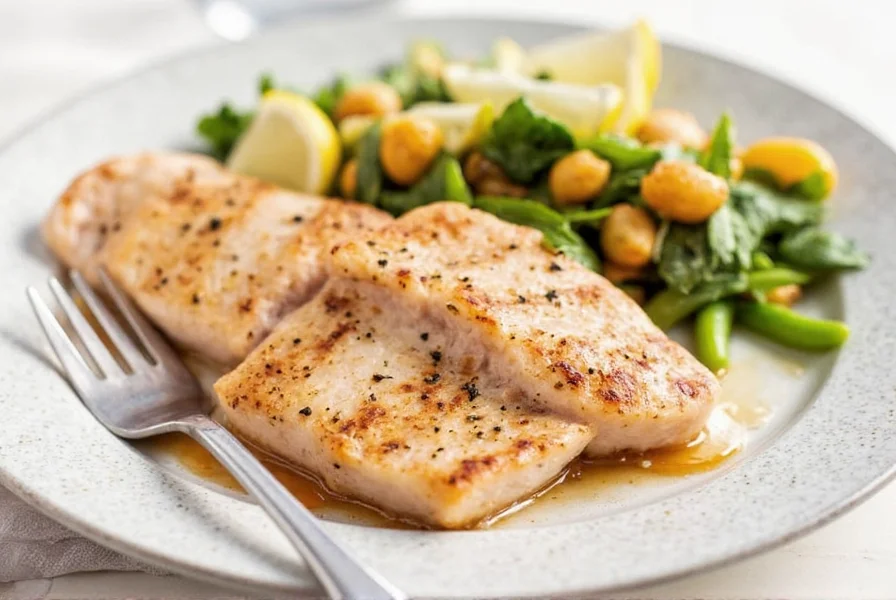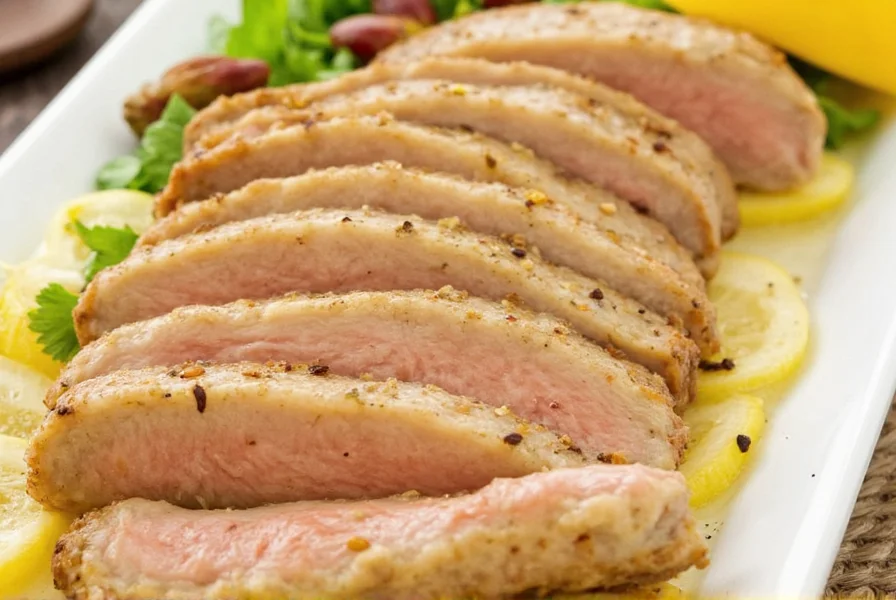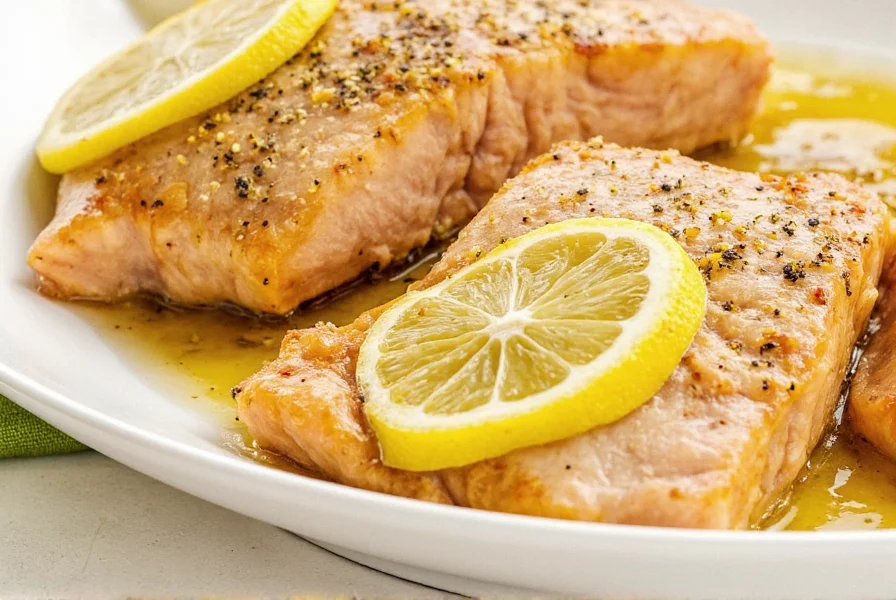Lemon pepper tuna has become a staple in healthy meal rotations for good reason. This versatile preparation method transforms high-quality tuna into a restaurant-quality dish with minimal effort. The natural richness of tuna pairs exceptionally well with the bright acidity of lemon and the subtle heat of freshly cracked pepper, creating a balanced flavor profile that satisfies without overpowering the fish's delicate taste.
Why Lemon Pepper Complements Tuna Perfectly
Tuna's firm texture and rich flavor provide an ideal canvas for lemon pepper seasoning. Unlike more delicate fish varieties, tuna can withstand bold seasonings while maintaining its structural integrity during cooking. The citric acid in lemon juice helps tenderize the surface of the fish while enhancing its natural flavors, not masking them. When combined with freshly cracked black pepper—which releases volatile oils containing piperine—this creates a complex flavor experience that elevates rather than overwhelms the premium fish.
Essential Ingredients for Authentic Lemon Pepper Tuna
Creating exceptional lemon pepper tuna requires attention to ingredient quality:
| Ingredient | Quality Recommendation | Purpose |
|---|---|---|
| Tuna steak | 1-1.5 inches thick, sushi-grade if possible | Provides meaty texture that holds up to searing |
| Lemon | Fresh, unwaxed, firm texture | Offers bright acidity without artificial notes |
| Black pepper | Whole peppercorns, freshly cracked | Delivers complex heat and aromatic compounds |
| Olive oil | Extra virgin, cold-pressed | Creates perfect sear without burning |
Avoid pre-made lemon pepper seasoning blends that often contain excessive salt, fillers, or artificial ingredients. For the most authentic easy lemon pepper tuna recipe, freshly grated lemon zest combined with coarsely cracked black pepper delivers superior flavor complexity.

Step-by-Step Preparation Guide
Follow these professional techniques for restaurant-quality results at home:
- Prep the tuna: Pat steaks thoroughly dry with paper towels (critical for proper searing)
- Create seasoning blend: Mix 2 tsp freshly grated lemon zest with 1.5 tsp coarsely cracked black pepper
- Season: Press mixture evenly onto all sides of tuna, allowing 10 minutes for flavors to penetrate
- Heat pan: Use cast iron or stainless steel skillet over medium-high heat until shimmering
- Sear: Cook 2-3 minutes per side for medium-rare (adjust based on thickness)
- Finish: Squeeze fresh lemon juice over cooked tuna just before serving
Mastering the Perfect Sear: Professional Tips
Achieving the ideal crust while maintaining a tender interior requires specific techniques:
- Dry surface is essential: Moisture prevents proper Maillard reaction—pat tuna thoroughly before seasoning
- Oil temperature matters: Heat oil until it shimmers but doesn't smoke (around 375°F/190°C)
- Don't overcrowd the pan: Cook one steak at a time for even heat distribution
- Avoid moving the fish: Let it sear undisturbed for full crust development
- Rest before slicing: Allow 2 minutes resting time to redistribute juices
For those wondering how to cook lemon pepper tuna fillets without drying them out, remember that tuna continues cooking after removal from heat. Remove from pan when center still appears slightly translucent for perfect medium-rare results.
Nutritional Benefits of Lemon Pepper Tuna
This dish offers impressive nutritional advantages that make it ideal for health-conscious eaters:
- High-quality protein: 35g of complete protein per 4-ounce serving supports muscle maintenance
- Omega-3 fatty acids: Approximately 1.5g per serving supports heart and brain health
- Vitamin D: Provides 80% of daily value, crucial for immune function and bone health
- B vitamins: Rich in B12, B3, and B6 for energy metabolism and nervous system function
- Low mercury options: Albacore tuna contains lower mercury levels than some larger fish species
When prepared using the healthy lemon pepper tuna dinner method described here, this meal delivers substantial nutrition without excessive calories or unhealthy fats. The lemon enhances iron absorption from the tuna while the pepper contains piperine, which may improve nutrient bioavailability.
Serving Suggestions and Pairings
Complement your lemon pepper tuna with these pairing options:
- Green vegetables: Asparagus, broccolini, or green beans enhance the citrus notes
- Starchy sides: Quinoa, roasted sweet potatoes, or cauliflower rice for balanced nutrition
- Salads: Arugula with shaved fennel and lemon vinaigrette creates a refreshing contrast
- Sauces: Light lemon-dill aioli or avocado crema adds richness without heaviness
For meal prep enthusiasts seeking a quick lemon pepper tuna meal prep solution, cook the tuna to medium-rare, then store separately from sides. Reheat gently in a skillet with a splash of water to maintain moisture when ready to eat.

Common Mistakes to Avoid
Even experienced cooks make these errors when preparing lemon pepper tuna:
- Using low-quality tuna: Discolored or overly fishy-smelling tuna won't improve with seasoning
- Over-seasoning: Lemon pepper should enhance, not dominate, the tuna's natural flavor
- Cooking from cold: Bring tuna to room temperature before cooking for even results
- Overcooking: Tuna becomes dry and tough when cooked beyond medium
- Using pre-squeezed lemon juice: Contains preservatives that alter flavor profile
Variations for Different Preferences
Adapt this grilled lemon pepper tuna instructions for various cooking methods and dietary needs:
- Grilled version: Use high heat and minimal oil for smoky flavor (reduce cooking time by 30 seconds per side)
- Low-sodium option: Omit added salt and increase lemon zest to 3 tsp for brighter flavor
- Spicy variation: Add 1/4 tsp cayenne pepper to seasoning blend for heat lovers
- Herb-infused: Incorporate 1 tsp chopped fresh dill or thyme into the seasoning mixture
Storage and Reheating Guidelines
Proper storage maintains quality for future meals:
- Refrigeration: Store in airtight container for up to 2 days (longer storage degrades texture)
- Reheating: Warm gently in skillet with teaspoon of water over medium-low heat (2-3 minutes)
- Avoid microwaving: Causes uneven heating and rubbery texture
- Freezing: Not recommended as it significantly alters the delicate texture of cooked tuna
Understanding Lemon Pepper Tuna Nutrition Facts
Per 4-ounce serving of properly prepared lemon pepper tuna:
- Calories: 248
- Protein: 35g (70% of daily value)
- Fat: 11g (mostly healthy unsaturated fats)
- Carbohydrates: 0g
- Sodium: 75mg (naturally occurring, without added salt)
- Omega-3s: 1,500mg
These lemon pepper tuna nutrition facts demonstrate why this dish is popular among fitness enthusiasts and health-conscious eaters. The complete protein profile supports muscle recovery while the healthy fats contribute to satiety and nutrient absorption.
Frequently Asked Questions
What's the best cut of tuna for lemon pepper preparation?
Ahi (yellowfin) tuna steaks with 1-1.5 inch thickness provide the ideal balance of flavor and texture. Look for deep red color, firm texture, and minimal odor. Sushi-grade is recommended for raw or rare preparations, but standard fresh tuna works well for medium cooking.
How can I tell when lemon pepper tuna is perfectly cooked?
Perfectly cooked lemon pepper tuna should have a golden-brown crust on the outside with a slightly translucent center when cut. For medium-rare, cook 2-3 minutes per side for 1-inch thick steaks. The internal temperature should reach 125°F (52°C). Remember that tuna continues cooking after removal from heat.
Can I use frozen tuna for lemon pepper tuna recipes?
Yes, but thaw frozen tuna slowly in the refrigerator overnight for best results. Never cook tuna directly from frozen as it leads to uneven cooking and texture issues. Pat thawed tuna extremely dry before seasoning to ensure proper searing. Fresh tuna generally yields superior texture and flavor compared to frozen.
What's the difference between lemon pepper tuna and lemon pepper fish?
Lemon pepper tuna specifically uses tuna steak, which has a meatier texture and richer flavor than many other fish. While the seasoning approach is similar for various fish, tuna's density allows for higher-heat cooking without falling apart. Delicate fish like tilapia require adjusted cooking times and may need additional binding agents when using lemon pepper seasoning.
How long does homemade lemon pepper seasoning last?
Freshly made lemon pepper seasoning (without salt) keeps for 3-4 days in an airtight container in the refrigerator. The lemon zest begins to lose its volatile oils after this period, diminishing flavor intensity. For best results, prepare the seasoning blend immediately before use to capture maximum aroma and flavor complexity.











 浙公网安备
33010002000092号
浙公网安备
33010002000092号 浙B2-20120091-4
浙B2-20120091-4